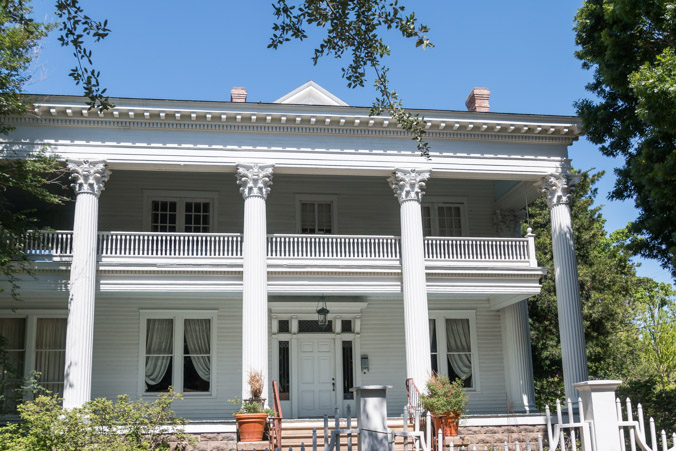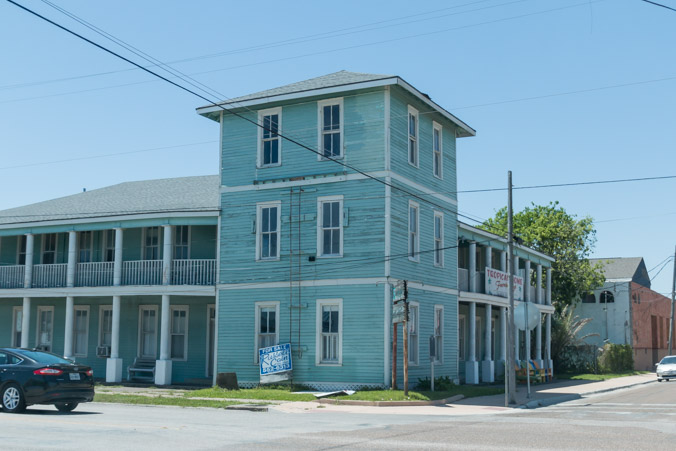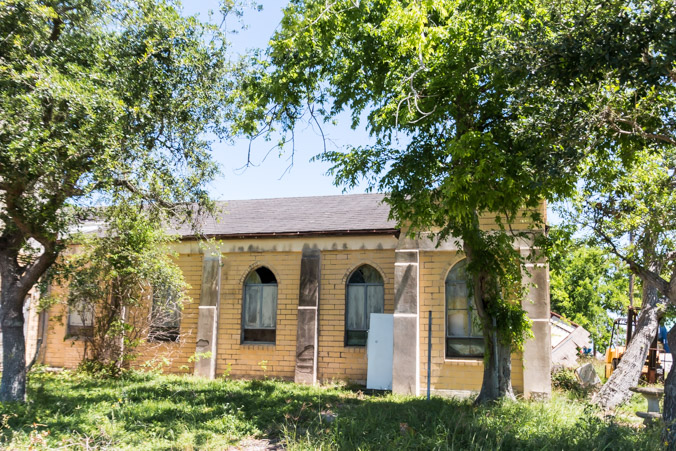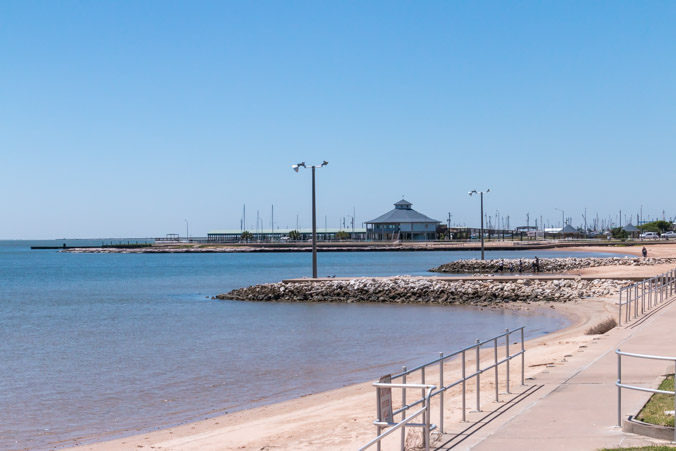
If you are a person of a certain age, you may remember the Sunday Drive. Those were the days when the whole family climbed into the car for the purpose of driving down the road, with no particular destination in mind, just to see what there was to see.
Simple curiosity is a lost art.
The Sunday drive is pretty much the way we travel every day of the week.
Driving around the country with nothing set in stone makes it easy to be flexible when the need for flexibility arises. Our current plan was loosely based on staying as close to the edge of the U.S. as possible, but when confronted with Corpus Christi, Texas we were having a bit of trouble finding a place to stay. Luckily, the couple we had dinner with in Del Rio, mentioned spending a month at a KOA in Victoria, Texas. They told us they’d really enjoyed the small town, quiet, atmosphere and we should check it out. So we altered our trajectory and headed slightly inland to stay at Victoria Coleto Creek Lake KOA.

The outskirts of Victoria, Texas is beautiful and rural, very green. Many people come here to fish in the reservoir behind the KOA and stay at the county campground. The city of Victoria itself is a treasure trove of art and history as we later learned.
The great thing about arriving during the off season means that we had the RV park almost to ourselves. The best part, for me, was the welcoming committee, a flock of Cattle Egrets.

A little Kildeer was convinced the campsite was his and was prepared to defend his territory.

The Kildeer stuck around the whole time and had something to say to us every day.
This campground was supposed to be our rest stop, we had not planned to stay here. On Sunday we had nothing to do so we figured it would be the perfect time for a Sunday drive.
Ice chest packed, we struck out for the center of town.
As we approached from the west, we spotted a tall spire and made that our destination. Spiraling in toward our goal, we came across this statue of a young Civil War soldier called The Last Stand. It was dedicated in 1912 by the daughter’s of the confederacy.

The bandstand, in the center of the town square, brings to mind ladies in bustle dresses setting out picnic hampers, while a barbershop quartet sings a cappella on the stage. The original bandstand was built in 1885 and moved to it’s current location in 1899. In 2003 a hurricane destroyed the historic structure and a new slightly larger one was built on the site.

Across the street we found the building with the spire.


This spectacular building is the 1892 Victoria courthouse. In 1891 the county judge held a competition for new courthouse building plans. This limestone structure was completed in ten months.
The competition and architectural history is explained on the plaque.

Victoria Texas is the county seat and the largest city in the region. It’s also one of the state’s old historic cities. The town was named Guadalupe Victoria for the first president of the republic of Mexcio and established in 1824 by Martin De Leon on the Guadalupe River at a site called Cypress Grove. It was an important stop on the La Bahia road as a stock raising center and shipping point for the port of Linnville. It was primarily a Mexican settlement but later, the Mexican residents fled and Victoria was incorporated under the Republic of Texas in 1839.
This is just an overview, but the city has a long and storied history.
Well worth reading about.
There are so many architecturally interesting buildings, old and new, that it’s difficult to take them all in. Something different around every corner.

As we circled around the town admiring the architecture, we began to notice green signs marked with the words Historical Tour and an arrow pointing the way. We started to follow them and they led us on a merry path through town, this way and that, from one gorgeous neighborhood to another.

At the time, I did not know the history of the buildings or anything about the tour itself. Searching Google when we got home, I discovered that Victoria takes great pride in it’s historical architecture. A map of the self guided tour can be obtained at the visitor center or online.
The following descriptions are taken from the online tour site here.
Today, Sunday, the place is a ghost town, there are no people on the streets, they’re all inside one of the magnificent churches like this one on Church Street.

This is St. Mary’s Catholic Church. It was also, like the town itself, established by Martin De Leon. It originally occupied a site on Main Street. The current Gothic Revival building was built in 1904.

Old Nazareth Academy also built 1904 is one of the cities most important architectural landmarks. It was built to house the convent school of the Sisters of the Incarnate Word and Blessed Sacrament, a French order.
Of all the buildings we saw I think this academy is my favorite.

C I Thurmond built this brick building in 1898 in the (then) heart of Victoria’s riverfront business district. Reputedly patterned after a New Orleans bordello, it has served as a grocery store, a mercantile, a farmer’s cooperative and is currently the art league community center.


The unusual thing about this beautiful Queen Anne dwelling, is that it housed a mortuary for several decades.
Speaking of mortuaries, I can’t find any history about this. There is a modern, 1960’s style, mortuary next door but this is just cool!
A perfect setting for a horror film.

There’s something for everyone here, even some western influence.

The residential side streets were a patchwork of sweeping oak trees, vibrant flowers, white pillars and curly black wrought iron.
Here are a few “drive by” details.

The Alexander Lowe house.
This is the third site for this residence. Built in the mid 1800’s, probably in another area and then moved to Victoria. Purchased in 1863 by Lowe, it was located on Main Street. Purchased again in 1940, it was renovated and moved to it’s present location.

No history listed for this home…

…Or this one but I like the way they looked. It’s difficult to get pictures driving by, the homes are surrounded by foliage and giant trees.

In 1927 Thomas O’Connor, grandson of the legendary cattle king of Texas, Thomas O’Connor, had his parent’s palatial frame residence demolished and built this imposing Spanish Colonial Revival residence. It is still owned by the family.

Joe and Ella Mae Pickering house. Construction date unknown, purchased in 1908, remodeled in 1911.

Rancher James McFadden had this residence designed as a gift for his daughter Emily and her husband James Ferdinand McCan. Constructed in 1908, McCan was an artist whose murals grace the interior. I would love to see that!
The painted details add so much charm.

No history on this house.

Jacob Henry Fox built a cotton gin and gristmill on this block in 1876. His house on this site was built in the 1860’s, it was incorporated into this larger house around 1890. In that year the gin and mill burned but Fox rebuilt both at this site.

George Edwin Jordan House built in 1885.

Proctor Vandenberge house. In 1893 Proctor a noted lawyer dramatically enlarged the existing structure. In the early 1930’s the exterior was redesigned.

Unidentified home.
There are over 80 homes and structures on the tour and most have a much more detailed history than I’ve outlined here. Driving through the separate districts of town was like driving through a cross section of history.
As we neared the outskirts we came upon this old school.

How much fun would fire drill day be? Slides!
Mitchell School was Victoria’s first public high school. It originally had three floors. the third floor was of frame construction and housed the library and auditorium. It was completed in 1901 but fires have plagued the structure. The first was in 1921, it was minor but a 1935 fire heavily damaged the third floor. The son of the original architect repaired the building. In 1943 a fire destroyed the third floor and it was never replaced.
I can’t help but wonder if the slides were put in because of the multiple fires!
Unfortunately that’s all we can explore of Victoria today since everything is closed. The town seems to have a very active arts community and the website mentions several historical activities as well. I wish we had more time.
Our Sunday drive continues as we head down highway 87 toward Port Lavaca to see what we can see.

This old silo structure has seen better days, I wonder what history it would tell.
Port Lavaca is a charming, one street, historic, beach town. It looked like a ghost town today with no people out and about but there are touches of art and care on the buildings.
The old theater marquee was advertising Iguana Fest April 6th and 7th.
Sounds like a hoot!


Port Lavaca has an interesting history, it was founded in the aftermath of the Linnville raid of 1840, a Comanche attack that swept through Victoria and Linnville. The burning of Linnville prompted many of it’s citizens to move to the site that is now Port Lavaca. The town eventually became a busy port.
At the end of the street we found a park where we learned that it also played an important part in the Civil War.

Several garrison’s were stationed around the town which had a large Confederate arsenal and small arms manufactory. During the war a Lavaca resident Capt. Edgar Collins Singer, designed an underwater mine which he tested successfully in February 1863.

I had no idea!
Port Lavaca also had old buildings.

It’s a bit more difficult to find the history of the buildings here but I did find out that this one was originally known as The Beach Hotel. It was constructed in 1904 and at the time was the tallest building in town. Traveling salesman frequently lodged here as did tourists who came to the coast looking for recreational opportunities. It’s now an apartment complex.

The unusual details of this old church caught my eye, stair stepped side supports, old stained glass. It was so overgrown with trees that I couldn’t get a full picture. It looks abandoned and I was unable to find it’s history.

I love the brick facade and window details on this building.

A shell of its former self. I did learn that Port Lavaca sustained a six foot storm surge during Hurricane Harvey, I’m not sure if any of the building damage we saw was from that disaster.

Port Lavaca’s main street committee has been working to revitalize the downtown. One of their projects has been a pocket park which was created by removing the interiors of two buildings and restoring the facades. The pictures I saw did not show this wall damage, perhaps caused by the hurricane?

This hardware store is Port Lavaca’s oldest business. It’s been serving customers since 1917. Declared a historical landmark, it was full of all sorts of everything, the way hardware stores used to be.


The feed store with a loading dock right next to the railroad tracks.

Half Moon Reef Lighthouse was moved ashore from it’s perch above the waters of Matagorda Bay. It was built in 1858 and was unusual in that it allowed a keeper to work with his wife and raise children there. There are fascinating stories about this lighthouse. Stories of sleepwalking children, the disappearance of a keeper, survival of the structure during the Civil War and more.
Port Lavaca has been explored.
It’s still early. Over the bridge to Point Comfort we go.

Point comfort is a hub of industry.
On the right, as we approach, Alcoa Aluminum Refinery is visible.

No refining is being done, it sits idle at this time.

On the left is the Formosa Plastics corporation which is a massive operation that covers a huge amount of land. A tract of homes sits across the street, perhaps company housing.


Cruising along highway 35 the next town in line is Palacios.
There is a legend that a Spanish ship sailing into the Gulf was carried into Matagorda Bay and wrecked. The sailors thought they saw palaces on the shoreline in the distance and so swam toward shore. As they neared the shore the mirage of the “palaces” disappeared. The bay and creek were actually named Tres-Palacios after Jose Trespalacios, Spanish governor during the years 1822 and 1823.
In 1903 a grand hotel was built in this seaside community. It was originally known as the Bay View Hotel, then the Palacios Hotel and finally the Luther Hotel.


It was built in three sections and subsequently moved. It was originally known as having the largest wrap around porch. It has survived both hurricanes and fire and continues to welcome guests who want to enjoy a simpler time. Many famous people have stayed here and word has it that the hotel is haunted.
Living in the land of earthquakes as we do, this type of foundation never ceases to amaze me!

The hotel has seen some changes through the years. The porch was removed as was the original chimney and fireplace. Wings were added to the side and the Luthers built a motor court in the 1930’s.

The newer motor court is not standing up to the test of time the way the much older, wood frame hotel is.

The far end is collapsing.
In 1904 a “pleasure pavilion” was built on the nearby pier. Damaged by hurricanes and rebuilt multiple times, a current version still exists.

In 1901 the Palacios City Townsite Company had begun promoting Palacios as a Health Resort town and selling plots of land for housing.
In 1906 John T. Price moved his family from Tennessee and built this house on the waterfront near the Luther Hotel.

The downtown area is also full of unique structures.


1910 R.J. Hill building.

This is listed as a 100 year old commercial building.

No history found.

World’s smallest fire department?

It’s time for us to move on from Palacios and toward home via the back roads.
A few sights on the way.

Shrimp boats.

More old buildings in even smaller towns.

Last but not least, a cornfield fire.

The local fire department was on hand to protect the home.
All in all, a successful day of sight seeing.